Witches' Brooms
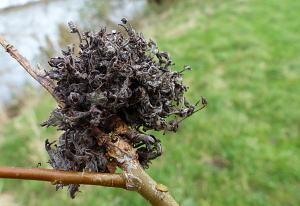 Witches' Brooms, galls comprising a cluster of twigs, caused the ascomycete fungus Taphrina betulina, are well known on Birch trees. Another type of Witches' Broom can be found on Willows and Sallows. Several were seen on Willows on the edge of Hornsea Mere during the Hull Nats trip on 6th November. This gall is formed from a catkin and can vary in appearance. The ones I saw seemed to be a mass of small dull greyish brown leaf-like structures. The identity of the gall causer is uncertain. These galls often contain eriophyoid mites (Stenacis triradiatus), which even as adults look a bit like tiny maggots with two pairs of anterior legs. However it is thought that the mites could be a vector for a virus which causes the gall. It is also possible that the galls might be caused by a phytoplasma. Phytoplasmas are specialised bacteria lacking a cell wall that live in the phloem of plants and are transmitted by sap-sucking insects. Disruption of the phloem transport of sugars and other products might lead to the development of distorted catkins.
Witches' Brooms, galls comprising a cluster of twigs, caused the ascomycete fungus Taphrina betulina, are well known on Birch trees. Another type of Witches' Broom can be found on Willows and Sallows. Several were seen on Willows on the edge of Hornsea Mere during the Hull Nats trip on 6th November. This gall is formed from a catkin and can vary in appearance. The ones I saw seemed to be a mass of small dull greyish brown leaf-like structures. The identity of the gall causer is uncertain. These galls often contain eriophyoid mites (Stenacis triradiatus), which even as adults look a bit like tiny maggots with two pairs of anterior legs. However it is thought that the mites could be a vector for a virus which causes the gall. It is also possible that the galls might be caused by a phytoplasma. Phytoplasmas are specialised bacteria lacking a cell wall that live in the phloem of plants and are transmitted by sap-sucking insects. Disruption of the phloem transport of sugars and other products might lead to the development of distorted catkins.
Richard Shillaker, 26 November 2021
Dead Man's Fingers
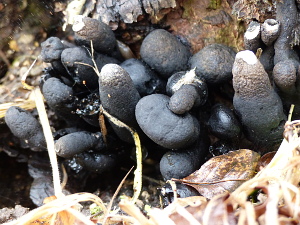 This fungus Xylaria polymorpha, commonly called Dead Man’s Fingers, was found at the base of a stump of a cut down tree in Brantingham on 4th November. The white powder on the tips of the fingers consists of the asexually produced conidiospores. The fungus also reproduces sexually via dark brown ascospores.
This fungus Xylaria polymorpha, commonly called Dead Man’s Fingers, was found at the base of a stump of a cut down tree in Brantingham on 4th November. The white powder on the tips of the fingers consists of the asexually produced conidiospores. The fungus also reproduces sexually via dark brown ascospores.
Richard Shillaker, 17 November 2021
Green Island in Beech leaf
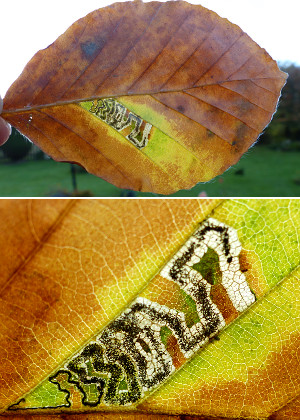 I spotted a small green/yellow patch (green island) in an otherwise brown leaf on a Beech tree in Welton Dale. The green/yellow area contained the twisting mine of the larva of a micromoth, the Small Beech Pigmy Stigmella tityrella (mine characterised by starting in angle of a vein close to the midrib). The larva of this moth is thought to have a symbiotic bacterium which is responsible for causing the release of cytokinins which delay leaf senescence (keeping the leaf green and containing nutrients), thus maintaining a food source for the larva. The green island in this leaf is turning yellow, probably because the larva is no longer present.
I spotted a small green/yellow patch (green island) in an otherwise brown leaf on a Beech tree in Welton Dale. The green/yellow area contained the twisting mine of the larva of a micromoth, the Small Beech Pigmy Stigmella tityrella (mine characterised by starting in angle of a vein close to the midrib). The larva of this moth is thought to have a symbiotic bacterium which is responsible for causing the release of cytokinins which delay leaf senescence (keeping the leaf green and containing nutrients), thus maintaining a food source for the larva. The green island in this leaf is turning yellow, probably because the larva is no longer present.
Richard Shillaker, 13 November 2021
A cautionary tale
 While searching through the Mappleton parish registers for a family baptism I came across the following unusual entry for 1687 -
While searching through the Mappleton parish registers for a family baptism I came across the following unusual entry for 1687 -
May : 27 : Richard the sonne of William Bayron was buried being slain as he was climbing a glead nest in [?only Lords aparell?] upon Whitsunday – remember ye Sabath day to keep it Holy
Glead is the old folk name for a Kite.
Richard Middleton, 7 October 2021
Sea Aster Mining Bees
Colletes halophilus
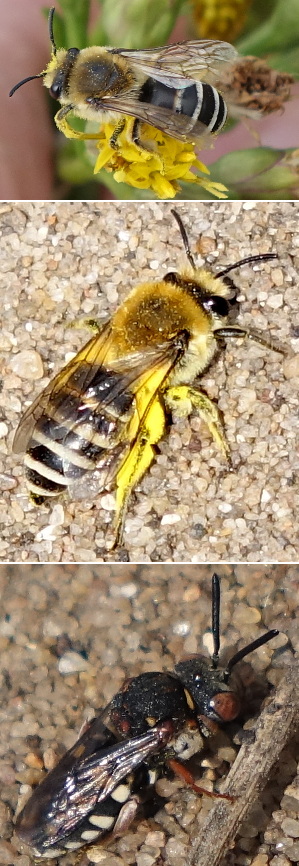 We found these rare solitary bees foraging for pollen and nectar on the abundant Sea Aster (Aster tripolium) at Skeffling [top]. Africa then led us to where there are known nesting aggregations in sand pits at Welwick Saltmarsh [middle], where there is also abundant Sea Aster, here protected by fencing from grazing sheep. The Sea Aster is their key food plant for pollen, though they will nectar from other plants. The global population is all on southern North Sea coasts up to the Humber, in such saltmarsh habitats.
We found these rare solitary bees foraging for pollen and nectar on the abundant Sea Aster (Aster tripolium) at Skeffling [top]. Africa then led us to where there are known nesting aggregations in sand pits at Welwick Saltmarsh [middle], where there is also abundant Sea Aster, here protected by fencing from grazing sheep. The Sea Aster is their key food plant for pollen, though they will nectar from other plants. The global population is all on southern North Sea coasts up to the Humber, in such saltmarsh habitats.
We also spotted several of their cleptoparasites, the Epeolus variegatus bee [bottom]. This small cuckoo bee will wait to enter a provisioned Colletes nest tunnel to lay its egg, which will then hatch to consume the host larva and its food supply.
The Colletes halophilus bees fly late in the season to coincide with the flowering of their food source. They are classified as a SPIE (Species of Principal Importance in England) by UKBAP.
References:
Helen Kitson, 12 September 2021
A serendipitous hoverfly record
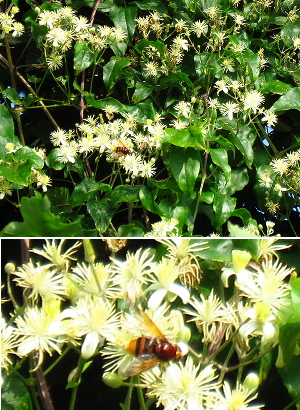 I have been trying to record plants at the Sculcoates patch, aided by the distribution in the Hull plant project maps. I noticed Traveller's-joy is not that common in Hull, but today I found a large plant flowering by the railway line just outside the km square at TA09173100. It is very obvious now that it is flowering. I took a record shot and when I checked it at home I realised that there is a Volucella zonaria in it. Not a common hoverfly by any means!
I have been trying to record plants at the Sculcoates patch, aided by the distribution in the Hull plant project maps. I noticed Traveller's-joy is not that common in Hull, but today I found a large plant flowering by the railway line just outside the km square at TA09173100. It is very obvious now that it is flowering. I took a record shot and when I checked it at home I realised that there is a Volucella zonaria in it. Not a common hoverfly by any means!
Africa Gómez, 3 August 2021
Toad (deceased) - Aldbrough, August 1
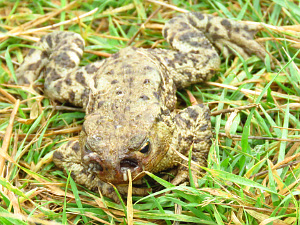 A freshly-dead Common Toad found beside the path at Aldbrough. The animal had an infection of a fly, Lucilia bufonivora, the larvae of which feed on the tissues around the nostrils.
A freshly-dead Common Toad found beside the path at Aldbrough. The animal had an infection of a fly, Lucilia bufonivora, the larvae of which feed on the tissues around the nostrils.
Africa Gómez, 2 August 2021
Oak Eggar
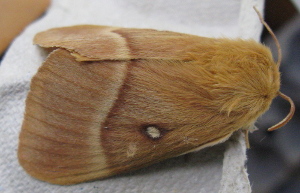 Among the many delights awaiting in my moth trap yesterday morning was this huge female Oak Eggar, pictured above on the side of an egg-box. This moth is usually more likely to be encountered on the North Yorkshire Moors than Holderness.
Among the many delights awaiting in my moth trap yesterday morning was this huge female Oak Eggar, pictured above on the side of an egg-box. This moth is usually more likely to be encountered on the North Yorkshire Moors than Holderness.
Richard Middleton, 22 July 2021
Shropshire Weekend 2021
The weather forecast was not encouraging, overcast and damp, threats of rain … very little in the way of sunshine, but that did not deter us. Andrew Chadwick led off on Friday afternoon with a well-researched walk from Dinham bridge on the winding river Teme, via a steep wooded hillside up to what remains of Whitcliffe Common. We admired the delicate woodland grasses and the ferns.
On Saturday a smaller group visited a corner of the extensive and unspoiled Catherton Common, which has evaded afforestation and never been sprayed with chemicals. Our walk took us from heathland down through marsh to valley mire, acid habitats with a typical plant assemblage.
Later we explored the Cramer Gutter SSSI, a very marshy area noted for its large number of sedges. Exciting to the group as a whole was the discovery of Marsh Violet leaves in all of the wetter areas and two Small Pearl-bordered Fritillaries fluttering above their food plant! The star fern find was Narrow-buckler and Helen spotted a Water Shrew in the stream, swimming underwater.
On Sunday we were on perhaps more familiar territory with a visit to Stretton Westwood Quarry. A fine array of limestone plants had grown up along with ruderal species, bird sown introductions and garden escapes.
Gabrielle Jarvis, 27 June 2021
Greater Butterfly-orchid
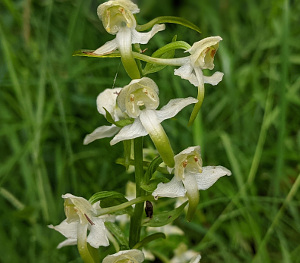 Whitcliffe Common
Whitcliffe Common
Helen Kitson, 25 June 2021
Small Pearl-bordered Fritillary
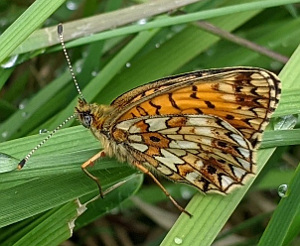 Cramer Gutter SSSI
Cramer Gutter SSSI
Helen Kitson, 26 June 2021
Raincliffe Wood 9 May
A day later than originally planned, five members assembled on a fine spring morning, very pleased that they did not have to endure yesterday’s torrential rain. Raincliffe and Forge valley are always a delight at this time of the year and we were treated to fine display of seasonable flowers, some such as the Moschatel or “Town-hall Clock” (Adoxa moschatellina) scarce or absent from our own vice-county. A pleasant, if occasionally sporting, walk around the wood produced a list of a hundred plant species. The birds were perhaps a little shy or preoccupied but on the limited list we did manage to record Garden Warbler, Nuthatch and Marsh Tit.
The visit was rounded-off for some of the party by a successful foray to a nearby site to see May Lily (Maianthemum bifolium) – a very rare plant - now seen on two Hull Nats Field trips this year!
Richard Middleton, 11 May 2021
Raincliffe Wood - pictures
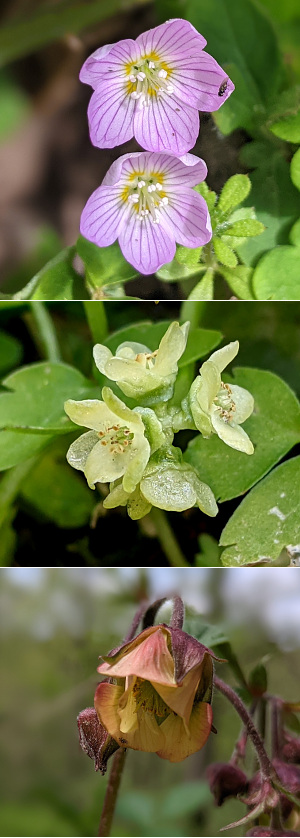
- Wood Sorrel (Oxalis acetosella)
- Moschatel (Adoxa moschatellina)
- Water Avens (Geum rivale)
Helen Kitson, 11 May 2021
Leucistic crow
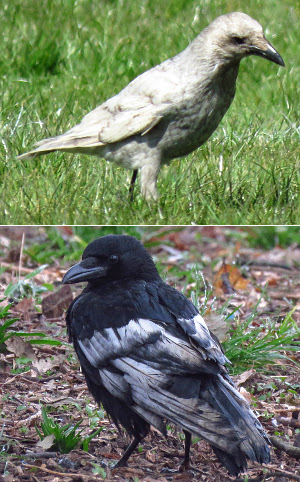 As I walked by the Oak Road playing fields yesterday I noticed an odd bird feeding on the grass. I couldn't believe my eyes: it is a silvery crow! I remembered that Andy Gibson messaged me about such a bird on New Years Day. I went to find it the following day and I have been visiting the area regularly, so it has taken me over 4 months to find it. It is likely to be a genetic variant of the usual colour plumage, instead of it being due to poor nutrition (as exemplified by this very tame young bird at West Park). Carrion Crow young being fed on bread appear to suffer from discolouration of their primaries, and are more frequent around public parks. They might grow black feathers in their next moult, but in the meantime, the white feathers fray more easily and sometimes these crows look like they have to make more effort to fly.
As I walked by the Oak Road playing fields yesterday I noticed an odd bird feeding on the grass. I couldn't believe my eyes: it is a silvery crow! I remembered that Andy Gibson messaged me about such a bird on New Years Day. I went to find it the following day and I have been visiting the area regularly, so it has taken me over 4 months to find it. It is likely to be a genetic variant of the usual colour plumage, instead of it being due to poor nutrition (as exemplified by this very tame young bird at West Park). Carrion Crow young being fed on bread appear to suffer from discolouration of their primaries, and are more frequent around public parks. They might grow black feathers in their next moult, but in the meantime, the white feathers fray more easily and sometimes these crows look like they have to make more effort to fly.
Africa Gómez, 14 April 2021
Butterbur, Snuff Mill Lane
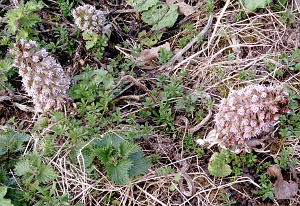
Annie Horne, 24 March 2021
Siskins
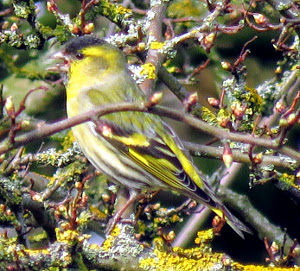 I've been for a long walk to the north limits of the city following the Beverley and Barmston drain. Had a close look at the Mistletoe, and nearby was a little flock of Siskin coming down to drink on a puddle after feeding on the Alders. Also had my first Colt's-foot by Oak Road Lake, and my 2nd picnic of the year!
I've been for a long walk to the north limits of the city following the Beverley and Barmston drain. Had a close look at the Mistletoe, and nearby was a little flock of Siskin coming down to drink on a puddle after feeding on the Alders. Also had my first Colt's-foot by Oak Road Lake, and my 2nd picnic of the year!
Africa Gómez, 15 March 2021
A new local patch ...
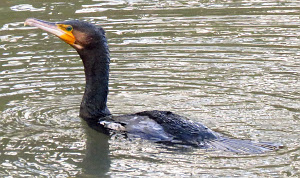 As the lockdown was announced, a strong sense of déjà vu, what to do? how to fill the quota of wildlife I need to stay afloat from the madness of this world. I need a local patch, within walking distance, and diverse enough in habitats that it will keep me busy recording in it. So I decided onto Sculcoates square (TA0930), with a river, a drain, lots of scrubby, brownfield places and three cemeteries. I have planned to visit at least weekly year round and if you want to follow my patch adventures, check my web blog.
As the lockdown was announced, a strong sense of déjà vu, what to do? how to fill the quota of wildlife I need to stay afloat from the madness of this world. I need a local patch, within walking distance, and diverse enough in habitats that it will keep me busy recording in it. So I decided onto Sculcoates square (TA0930), with a river, a drain, lots of scrubby, brownfield places and three cemeteries. I have planned to visit at least weekly year round and if you want to follow my patch adventures, check my web blog.
Africa Gómez, 9 January 2021
Anlaby Common
An internet photograph posted by Peter Church [Geography] shows extensive pools of water on Anlaby Common in February 2008 following a wet winter. Peter commented that the Common would soon be invaded by frogs and then the pools would be full of spawn.
Some 10-20 years earlier, large rafts of Common Frog Rana temporaria spawn had been recorded on the Common by Paul Benson [British Herpetological Society]. The main breeding site was a wide water-filled depression about 30 metres from the eastern boundary of back gardens. The area usually dried out by late summer, although sometimes sooner when much spawn would have perished. He estimated the annual number of clumps as 1986 >500; 1987 >3000; 1996 >900; 1998 >1000.
These observations show how important Anlaby Common has been as a breeding site for the Common Frog.
Such an abundance of breeding frogs would have attracted amphibian predators to the Common. It is notable that a White Stork Ciconia ciconia, was seen feeding on frogs on the flooded Common in April 2001 [Broughton, Birds of the Hull area]; a photograph of the bird with an anuran in its bill is featured in the YNU's Yorkshire Rare and Scarce Birds Report 2001. The stork was first seen on the 2nd April and remained there until the 5th. A photograph apparently taken about 30 years ago of another rare bird, the Great Grey Shrike Lanius excubitor, on Anlaby Common was posted on Twitter recently. As this species is known to include amphibians in its diet, I wonder if it was attracted to the Common by the frogs (although the month the bird was seen is not recorded).
Richard Shillaker, 3 January 2021
Red-crested Pochard
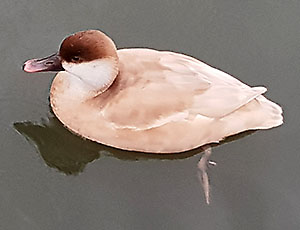 Chris Sulston spotted this female Red-crested Pochard on East Park lake at the end of last year. They occur commonly in Europe, but are fairly rare visitors or escapees in the UK. East Park has a good selection of waterfowl and is well worth a visit.[AC]
Chris Sulston spotted this female Red-crested Pochard on East Park lake at the end of last year. They occur commonly in Europe, but are fairly rare visitors or escapees in the UK. East Park has a good selection of waterfowl and is well worth a visit.[AC]
picture- Chris Sulston
Skipwith Common visit
17 October 2021
 We were grateful when the lashing rain stopped just as we arrived at King Rudding Lane. We found over 40 species of fungi, and other highlights included three Black Darter dragonflies, two Leopard Slugs, one with eggs, and a nest of baby newts, all found by Africa.
We were grateful when the lashing rain stopped just as we arrived at King Rudding Lane. We found over 40 species of fungi, and other highlights included three Black Darter dragonflies, two Leopard Slugs, one with eggs, and a nest of baby newts, all found by Africa.
Two fungi which were easy to identify in the field were the Sulphur Knight, Tricholoma sulphureum (top) and the Aniseed Funnel, Clitocybe odora (bottom). These are not just recognisable by colour but by their distinctive odours. The Sulphur Knight is sometimes described as the 'coal gas mushroom' and the Aniseed Funnel was described variously by members of the group as smelling of 'hay', 'lavender' and 'fennel'.
Helen Kitson, 24 October 2021
Skeffling & Welwick
11 September 2021
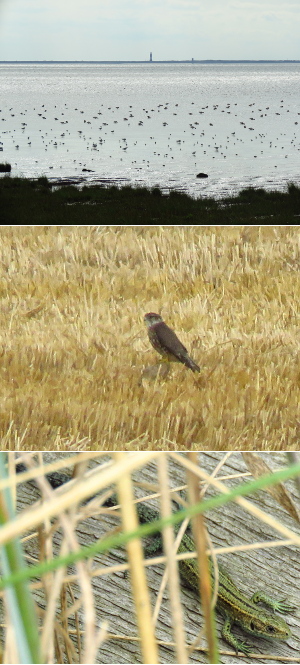
- Birds feeding on the Humber mud
- Voucher image of a Merlin resting in an adjoining field
- A Common Lizard seen along the bank
Africa Gómez, 14 September 2021
Sea Slaters
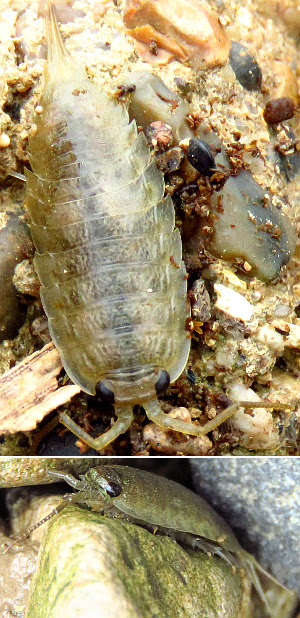 I went to Victoria Dock area on Tuesday. At the end of Corinthian Way, there is a little bit of a beach (the only beach in Hull!) The beach is shingle, although, this having been a shipyard a few decades ago, there is also plenty of rubble and even some rocky patches, possibly made out of slag. Some salt marsh plants have established, including Sea Aster and Marram Grass. I noticed the tide line of wrack and had a poke to check what was under it. There were many sandhoppers, far too quick for photos, but I managed to get a few photos of some sea slaters, Ligia oceanica, the largest I've seen, about 3 cm long. These are relatives of woodlice and usually live in rocky shores.
I went to Victoria Dock area on Tuesday. At the end of Corinthian Way, there is a little bit of a beach (the only beach in Hull!) The beach is shingle, although, this having been a shipyard a few decades ago, there is also plenty of rubble and even some rocky patches, possibly made out of slag. Some salt marsh plants have established, including Sea Aster and Marram Grass. I noticed the tide line of wrack and had a poke to check what was under it. There were many sandhoppers, far too quick for photos, but I managed to get a few photos of some sea slaters, Ligia oceanica, the largest I've seen, about 3 cm long. These are relatives of woodlice and usually live in rocky shores.
Africa Gómez, 19 August 2021
White-letter Hairstreak
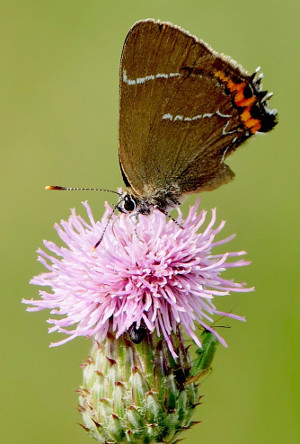 At the last minute, I decided to take my camera on Daisy’s walk over Beverley Westwood. While walking along the western boundary and looking at a couple of dragonflies, out of the corner of my eyes, I saw something land on a thistle head. I was too far away to see what it was so I took a photo (600mm equivalent lens). When I zoomed in to see what it was I realised it was a White-letter Hairstreak so took a few more. As it seemed settled, I changed position, knelt down so I only had grass in the background and took the above shot. I believe they have been seen in Thwaite Gardens but, otherwise, are not known from this area.
At the last minute, I decided to take my camera on Daisy’s walk over Beverley Westwood. While walking along the western boundary and looking at a couple of dragonflies, out of the corner of my eyes, I saw something land on a thistle head. I was too far away to see what it was so I took a photo (600mm equivalent lens). When I zoomed in to see what it was I realised it was a White-letter Hairstreak so took a few more. As it seemed settled, I changed position, knelt down so I only had grass in the background and took the above shot. I believe they have been seen in Thwaite Gardens but, otherwise, are not known from this area.
Mervin Nethercoat, 11 August 2021
Corbicula fluminalis
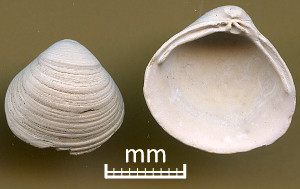 On our Tuesday evening visit to Keyingham Gravel Pit I was able to collect several shells of the small fresh-water bivalve Corbicula fluminalis. Although mixed in with a range of marine molluscs, such as Cockle, still commonly found around our coast, these are now only encountered in fresh, warm water and are long extinct in Britain. It is believed that they represent animals once living in the streams which re-shaped the local landscape as the ice of the last glacial period melted. The marine shells, which are often broken, were derived from sediment incorporated into the glaciers as they moved over the sea floor.
On our Tuesday evening visit to Keyingham Gravel Pit I was able to collect several shells of the small fresh-water bivalve Corbicula fluminalis. Although mixed in with a range of marine molluscs, such as Cockle, still commonly found around our coast, these are now only encountered in fresh, warm water and are long extinct in Britain. It is believed that they represent animals once living in the streams which re-shaped the local landscape as the ice of the last glacial period melted. The marine shells, which are often broken, were derived from sediment incorporated into the glaciers as they moved over the sea floor.
Richard Middleton, 14 July 2021
Choke Disease, Sutton
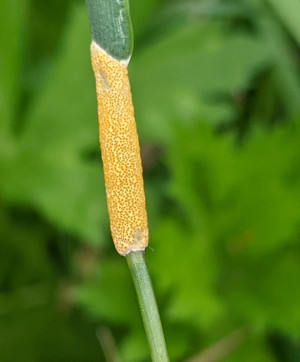 We discovered galls among a patch of grasses including Agrostis stolonifera in an unmown area of the Barbara Robson Aquagreen. Andrew discovered they had killed off the flowering shoots and quickly consulted his phone to discover it was Epichloe baconii, a 'choke grass' fungus. It only becomes visible when it’s ready to shed its spores in its sexual reproductive stage. This begins as a white collar around the immature flowerheads of mainly Agrostis species, inhibiting their growth. It then turns yellow/orange as spore-bearing asci (sacs) become visible (as in the picture). It seems that the fungus attracts flies from the genus Botanophila, which feed on the fungal material before laying their eggs on another grass of the species which is also infected. The fungus will then reproduce, and the fly larvae in turn will benefit from the food source of the fungi.
We discovered galls among a patch of grasses including Agrostis stolonifera in an unmown area of the Barbara Robson Aquagreen. Andrew discovered they had killed off the flowering shoots and quickly consulted his phone to discover it was Epichloe baconii, a 'choke grass' fungus. It only becomes visible when it’s ready to shed its spores in its sexual reproductive stage. This begins as a white collar around the immature flowerheads of mainly Agrostis species, inhibiting their growth. It then turns yellow/orange as spore-bearing asci (sacs) become visible (as in the picture). It seems that the fungus attracts flies from the genus Botanophila, which feed on the fungal material before laying their eggs on another grass of the species which is also infected. The fungus will then reproduce, and the fly larvae in turn will benefit from the food source of the fungi.
See - The Naturalists' Notebook The blog of the Merseyside Naturalists' Association
Helen Kitson, 7 July 2021
Peregrine - Kingswood
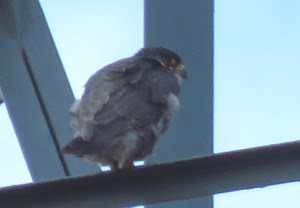 I walked north from Raich Carter Way on the river bank this morning and saw a Peregrine landing on one of the pylons
- wrong light, too windy and the Peregrine was intent on preening the back of its tail so I only got poor photos.
I walked north from Raich Carter Way on the river bank this morning and saw a Peregrine landing on one of the pylons
- wrong light, too windy and the Peregrine was intent on preening the back of its tail so I only got poor photos.
Africa Gómez, 6 July 2021
Bristol Road Aquagreen
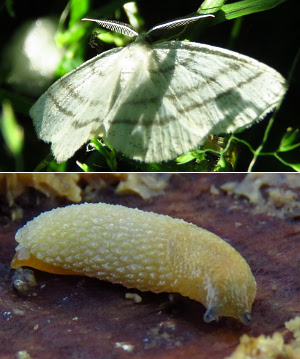
- Common White Wave
- Hedgehog Slug Arion intermedius
Africa Gómez, 23 June 2021
Toothed Door Snail, Welton
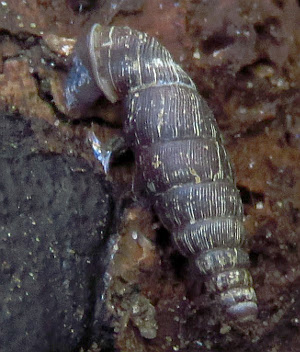 In the interesting visit to Welton Top on Tuesday I found this little door snail on a tree trunk. It is a Toothed Door Snail, Clausilia bidentata. Although a common species in the UK, records appear to be concentrated in the Wolds in East Yorkshire. It lives in woods and hedges and is active at night and in damp weather, when it climbs onto trees or rocks to feed on lichens.
In the interesting visit to Welton Top on Tuesday I found this little door snail on a tree trunk. It is a Toothed Door Snail, Clausilia bidentata. Although a common species in the UK, records appear to be concentrated in the Wolds in East Yorkshire. It lives in woods and hedges and is active at night and in damp weather, when it climbs onto trees or rocks to feed on lichens.
Africa Gómez, 20 May 2021
Allerthorpe 25 April
As a change, we met in Allerthorpe village and walked to the Common from the east through Tank Plantation. There were many fallen or dying birch trees supporting Hoof Fungus (Fomes fomentarius). The one in the photo had started life on an upright trunk before changing direction towards the ground when the trunk fell, to release its spores. Most of the usually dark grey fungi were a ghostly white colour. It looked like mould but this must have been the white spores, still coating the fruiting bodies due to the dry spring. Inside the tough outer layer, the pore material, or trama, is soft and a desiccant. It can spark easily and smoulder for hours. Hence its other name, Tinder Fungus, as carried by Otzi the Iceman. The processed trama, called amadou, is also used as a material for producing felt fabric.
There were plenty of singing warblers, including the Whitethroat photographed, and other summer visitors including Swallows and Cuckoo (heard but not seen). The increasingly common Red Kite was also spotted.
There was a respectable plant list although not much in flower, one exception being the Lousewort in the photo. The leaves of May Lily, one of the specialities of the reserve, were showing and there were signs of a flower on one specimen.
After some searching we eventually found a pair of Adders, one of the other well-known attractions of Allerthorpe. In the photo the female is brown and the male a light grey/green.
Helen Kitson & Andrew Chadwick, 1 May 2021
Allerthorpe - pictures

- Hoof fungus - Helen Kitson
- Whitethroat - Mervin Nethercoat
- Lousewort - Helen Kitson
- Adders - Andrew Chadwick
Wheldrake 10 April
 Four members attended our first field trip after the latest lockdown. There was a good range of birds, both on the water and in the woodland with the star record being a Great White Egret. Although early for many flowers, we found a patch of Rue-leaved Saxifrage (Saxifraga tridactylites)- top - not far from the car park. In the floodplain meadow were Cuckooflower (Cardamine pratensis) and Marsh-marigold (Caltha palustris) amongst what promises to be a good display of Great Burnet (Sanguisorba officinalis). We were interested to find most of the patches of Broad-leaved Dock crawling with iridescent green beetles which were busy mating and laying eggs - middle. These were identified as Green Dock Beetles (Gastrophysa viridula)! Other finds included the fungus Blushing Bracket (Daedaleopsis confragosa) and a slime mould, the False Puffball (Enteridium lycoperdon) - bottom - about to crack and release its spores.
Four members attended our first field trip after the latest lockdown. There was a good range of birds, both on the water and in the woodland with the star record being a Great White Egret. Although early for many flowers, we found a patch of Rue-leaved Saxifrage (Saxifraga tridactylites)- top - not far from the car park. In the floodplain meadow were Cuckooflower (Cardamine pratensis) and Marsh-marigold (Caltha palustris) amongst what promises to be a good display of Great Burnet (Sanguisorba officinalis). We were interested to find most of the patches of Broad-leaved Dock crawling with iridescent green beetles which were busy mating and laying eggs - middle. These were identified as Green Dock Beetles (Gastrophysa viridula)! Other finds included the fungus Blushing Bracket (Daedaleopsis confragosa) and a slime mould, the False Puffball (Enteridium lycoperdon) - bottom - about to crack and release its spores.
pictures - Helen Kitson
report - Andrew Chadwick
11 April 2021
Stranded whales
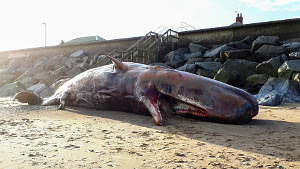 On the 30th of December I headed to Withernsea to see the stranded Sperm Whales. I've never seen a stranded whale before and I was saddened by their misfortune, but incredibly curious to see these animals up close. Five whales were stranded and a team was carrying out the necropsies. The individual closest to Withernsea is pictured in the photo.
On the 30th of December I headed to Withernsea to see the stranded Sperm Whales. I've never seen a stranded whale before and I was saddened by their misfortune, but incredibly curious to see these animals up close. Five whales were stranded and a team was carrying out the necropsies. The individual closest to Withernsea is pictured in the photo.
Africa Gómez, 9 January 2021
Botanists at work
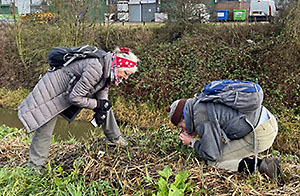
Valerie Fairhurst, 1 January 2021
Collared Earthstar - Beverley
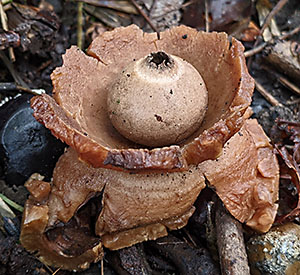
Helen Kitson, 1 January 2021
BSBI New Year Plant Hunt 2021
The BSBI organised the New Year Plant Hunt again this year, emphasising that participants must comply with any COVID restrictions in their area. For those who have not taken part before, the idea is to record all the flowering wild or naturalised plants that can be found during a 3-hour walk on a day during the New Year period, January 1st to 4th. Three members of the Society turned up for a walk round Beverley on January 1st. This is an area we have surveyed in previous years but, lacking any of our botanical heavyweights in the team, we only managed a total of 27 species compared to 42 in 2020 and 70 in 2019. Looking on the bright side, this is still significantly higher than the national average list length of about 18. The full list can be seen by going to BSBI results page and clicking the marker on the map. The weather turned out to be better than expected and it was a very enjoyable outing. Non-botanic highlights were a good view of a Grey Wagtail on Barmston Drain and the discovery of a group (or should that be a constellation?) of Collared Earthstars (Geastrum triplex).
Andrew Chadwick, 1 January 2021
Turions on Frogbit, Hydrocharis morsus-ranae
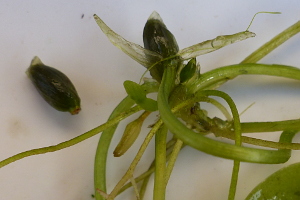 These small, dark green overwintering buds (turions) on Frogbit, from my garden pond, were photographed on 29th September. They look quite different to the turions of Whorled Water-milfoil featured in the news item below by Gabrielle Jarvis. An informative series of photographs showing the annual life cycle of Frogbit, including development of the turion in spring, can be found on the Sussex Wildlife Trust website. Frogbit is a rare plant ‘in the wild’ in East Yorkshire; I was with Ray Goulder when he found an extensive patch of Frogbit on Pocklington Canal at Storwood in 2017. Ray reports that Frogbit is now scattered along the canal and that it has spread into the Derwent. There is also a recent report from North Duffield Carrs.
These small, dark green overwintering buds (turions) on Frogbit, from my garden pond, were photographed on 29th September. They look quite different to the turions of Whorled Water-milfoil featured in the news item below by Gabrielle Jarvis. An informative series of photographs showing the annual life cycle of Frogbit, including development of the turion in spring, can be found on the Sussex Wildlife Trust website. Frogbit is a rare plant ‘in the wild’ in East Yorkshire; I was with Ray Goulder when he found an extensive patch of Frogbit on Pocklington Canal at Storwood in 2017. Ray reports that Frogbit is now scattered along the canal and that it has spread into the Derwent. There is also a recent report from North Duffield Carrs.
Richard Shillaker, 20 November 2021
Turions on Whorled Water-milfoil
 Retrieved by Bill Dolling rom the Barmston Drain on Swinemoor: bright green turion growing on Whorled Water-milfoil. A turion is a wintering bud formed from a modified shoot apex, produced in autumn. It will detach itself and sink to the bottom where the mud will be warm enough to preserve it, rising in spring.
Retrieved by Bill Dolling rom the Barmston Drain on Swinemoor: bright green turion growing on Whorled Water-milfoil. A turion is a wintering bud formed from a modified shoot apex, produced in autumn. It will detach itself and sink to the bottom where the mud will be warm enough to preserve it, rising in spring.
Gabrielle Jarvis, 21 September 2021
Buff-tip Moth at Welwick
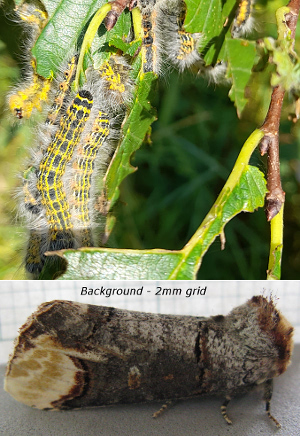 A group of Buff-tip caterpillars
found by Bill Dolling demolishing English Elm leaves at Welwick. The adult moth is perfectly camoflaged as a piece of dead twig but is sometimes caught in moth traps (below RM Wawne).
A group of Buff-tip caterpillars
found by Bill Dolling demolishing English Elm leaves at Welwick. The adult moth is perfectly camoflaged as a piece of dead twig but is sometimes caught in moth traps (below RM Wawne).
Gabrielle Jarvis, 16 September 2021
Longspine Thorn-apple
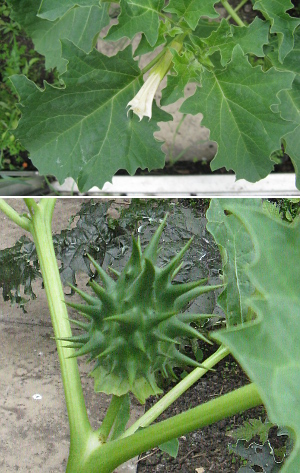 The above plant appeared in our greenhouse a few weeks ago and was allowed to grow until an identification was possible. The characteristic fruits show it to be Datura ferox - Longspine Thorn-apple.
The above plant appeared in our greenhouse a few weeks ago and was allowed to grow until an identification was possible. The characteristic fruits show it to be Datura ferox - Longspine Thorn-apple.
All parts of this alien plant are highly toxic and psycho-active. Rather worryingly the leaves bear a striking resemblance to those of the kale that it was growing alongside.
Richard & Kath Middleton, 22 August 2021
Hidden spider
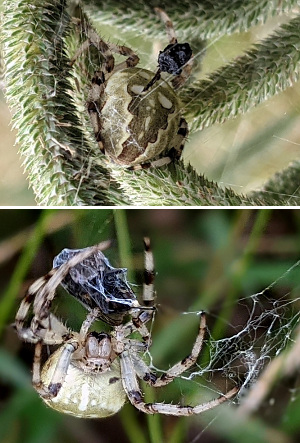 Four-spotted Orb Weaver Spiders (Araneus quadratus)are the heaviest spiders in the UK, the females (pictured) becoming swollen with eggs in late summer. They spin their webs close to the ground and prefer grasshoppers, but this one was packaging up a squirming fly until it spotted me looming with my mobile. It froze and then raced to the Timothy grass where it was expertly camouflaged. The females adjust their colouring over several days to match their homes.
Four-spotted Orb Weaver Spiders (Araneus quadratus)are the heaviest spiders in the UK, the females (pictured) becoming swollen with eggs in late summer. They spin their webs close to the ground and prefer grasshoppers, but this one was packaging up a squirming fly until it spotted me looming with my mobile. It froze and then raced to the Timothy grass where it was expertly camouflaged. The females adjust their colouring over several days to match their homes.
See the NatureSpot website
Helen Kitson, 29 July 2021
Venus's-looking-glass
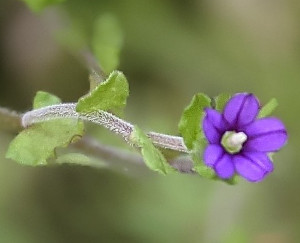 Found near Rudston in a field corner inaccessible to the crop sprayer, this tiny plant was once a common arable weed. Venus's-looking-glass is so-called because the seeds look like miniature hand mirrors.
Found near Rudston in a field corner inaccessible to the crop sprayer, this tiny plant was once a common arable weed. Venus's-looking-glass is so-called because the seeds look like miniature hand mirrors.
Gabrielle Jarvis, 14 July 2021
photo Gill Smith
Farndale - joint meeting with the
Ryedale Natural History Society
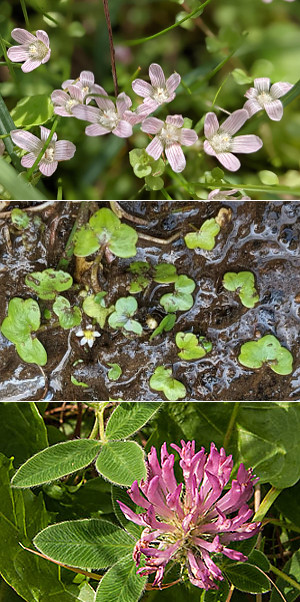
- Bog Pimpernel - Gill Smith
- Ivy-leaved Crowfoot - Gill Smith
- Zigzag Clover - Andrew Chadwick
A dozen people turned out for a glorious walk at Farndale with superb views and diverse habitats both limestone and acid. We saw and heard Curlews, while raptors soared over open grouse moor. Meadow Pipits had successfully raised fledglings. Unusual beetles included Welsh Chafer and a carrion beetle Thanatophilus rugosus. Some botanical finds: Chickweed-wintergreen under Bracken, Cow-wheat and in wetter areas Bog Pimpernel and tiny Ivy-leaved Crowfoot. Thanks to Gill Smith and colleagues.
Gabrielle Jarvis, 12 July 2021
Sea Spleenwort
 I walked by the marina yesterday between showers and remembered the Sea Spleenworts. Last summer they were looking quite dry and dishevelled, but they are back in good form, benefiting from the rains and unaffected by the recent flood defence works.
I walked by the marina yesterday between showers and remembered the Sea Spleenworts. Last summer they were looking quite dry and dishevelled, but they are back in good form, benefiting from the rains and unaffected by the recent flood defence works.
Africa Gómez, 13 July 2021
Small Elephant Hawkmoth
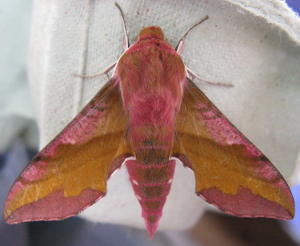 A pleasant surprise in my moth trap on Monday - a fine specimen of the relatively diminutive Small Elephant Hawkmoth. Normal service was resumed this morning with two examples of its much larger cousin the Elephant Hawkmoth, as pictured in last year's "News" of exactly the same date.
A pleasant surprise in my moth trap on Monday - a fine specimen of the relatively diminutive Small Elephant Hawkmoth. Normal service was resumed this morning with two examples of its much larger cousin the Elephant Hawkmoth, as pictured in last year's "News" of exactly the same date.
Richard Middleton, 16 June 2021
Flowering Rush - Alkborough
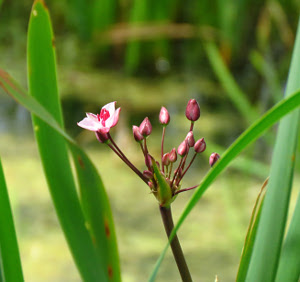 I went to Alkborough Flats today, I hadn't been since our Hull Nats visit the 20th October 2020. As I went by the path I remembered that botanists noted the dry flower stems of Flowering Rush and I looked for it. I found a single plant, and a single flower was open, what a beautiful marginal plant! I shall remember it.
I went to Alkborough Flats today, I hadn't been since our Hull Nats visit the 20th October 2020. As I went by the path I remembered that botanists noted the dry flower stems of Flowering Rush and I looked for it. I found a single plant, and a single flower was open, what a beautiful marginal plant! I shall remember it.
Other than that, most birds were very distant today and the water very high from the main hide. Still, the place was a veritable heron fest: 20+ Little Egrets, 15+ Grey Heron, 2 Bitterns heard, one flushed, 3 Great White Egrets, plus 6 Spoonbills, a dapper Spotted Redshank and 2 Avocets, Bearded Tits, Marsh Harriers, Cetti's galore and more. A telescope would have been ideal.
I had some good odonata too.
Africa Gómez, 14 June 2021
Owls in a Hull cemetery
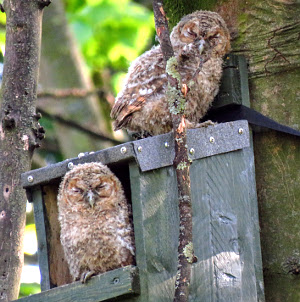 The Friends of the General Cemetery in Hull fitted a number of nest boxes in the cemetery last autumn, including two Tawny Owl boxes. You would think that with so many mature trees there wouldn't be a need. However, Tawny Owls rapidly occupied one of the nests. I was alerted to the presence of owlets at the nest entrance a couple of days ago by a friend. I visited them on May 6th and 7th, when I took photos. A wonderful experience! Despite having a nest in use in front of my house for years I had never seen the owlets. On the 7th one of the owlets had 'branched', where they leave the nest, even if they can't fly. I haven't seen them in the last few days so I presume they are now well camouflaged in nearby trees being fed by their parents.
The Friends of the General Cemetery in Hull fitted a number of nest boxes in the cemetery last autumn, including two Tawny Owl boxes. You would think that with so many mature trees there wouldn't be a need. However, Tawny Owls rapidly occupied one of the nests. I was alerted to the presence of owlets at the nest entrance a couple of days ago by a friend. I visited them on May 6th and 7th, when I took photos. A wonderful experience! Despite having a nest in use in front of my house for years I had never seen the owlets. On the 7th one of the owlets had 'branched', where they leave the nest, even if they can't fly. I haven't seen them in the last few days so I presume they are now well camouflaged in nearby trees being fed by their parents.
Africa Gómez, 12 May 2021
Barn Owl Pellets - Allerthorpe
 I've spent a couple of hours dissecting the three fresh pellets I collected from under the Pine tree nest box on our trip to Allerthorpe common on the 25th April. They contained a large number of shrews, with other prey being just 2 Field Voles and a couple of bird wing bones
I've spent a couple of hours dissecting the three fresh pellets I collected from under the Pine tree nest box on our trip to Allerthorpe common on the 25th April. They contained a large number of shrews, with other prey being just 2 Field Voles and a couple of bird wing bones
Pellet 1: 4 Common Shrew, 2 Pygmy Shrew, 2 long bird bones (wing probably)
Pellet 2: 5 Common Shrew, 4 Pygmy Shrew (above)
Pellet 3: 2 Field Voles, 3 Common Shrew, 1 Pygmy Shrew.
Africa Gómez, 3 May 2021
"Dirty sand"
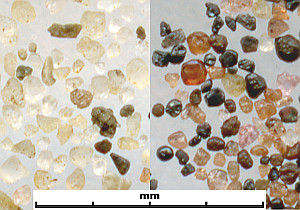 When visiting Easington at the end of last year I was struck by a broad band of brown, dirty-looking, sand at the top of the beach. I collected a sample of this material which proved to be half as heavy again as normal beach sand.
When visiting Easington at the end of last year I was struck by a broad band of brown, dirty-looking, sand at the top of the beach. I collected a sample of this material which proved to be half as heavy again as normal beach sand.
The above image shows ordinary quartz beach sand (left) compared with the dark sand (right). This demonstrated how effective the wave action had been at sorting the heavy garnet (pink and red grains) from the transparent quartz. The black grains were a mixture of magnetite (iron oxide) and ilmenite (iron-titanium oxide), the former of which is highly magnetic. With a fridge-magnet I was able to extract 10% by weight of the grains.
Moral - don't rely on your compass at Easington!
Richard Middleton, 8 April 2021
Fungi on dead Holly leaves
After seeing a simple pictorial guide for identifying fungi which apparently only grow on the dead leaves of Holly, Ilex aquifolium, I examined some brown holly leaves from under a local hedge. Several leaves had black speckling on both the upper and lower surfaces (see photos). This is a characteristic feature of the Ascomycete fungus Phacidium lauri [Naturespot]; it has no common name according to the British Mycological Society. The small round speckles are pycnidia which release asexual spores (conidia), ie spores produced by mitosis [Assynt Field Club].
Two other species of fungi only found on dead Holly leaves are the Holly Speckle (another Ascomycete) and the Holly Parachute (a Basidiomycete).
The Holly Speckle, Trochila ilicina, can be identified by finer black speckling restricted to the upper surface of the leaf [Naturespot]. These speckles have a lid which ’flips’ open to allow the release of sexual spores [Assynt Field Club].
The Holly Parachute, Marasmius hudsonii, looks completely different. It emerges from a dead leaf as a minute mushroom with a slender stalk. The pale pinkish cream cap, 2-6 cm diameter, has a covering of red-brown hairs [First Nature]. This fungus is reported to be associated with moist Holly leaves. A feature of this genus is that a dried out mushroom can recover if rehydrated.
All three species would appear to have a wide distribution in the UK, with the Holly Parachute being the least recorded species (173 records on NBN). However there are only three entries on iRecord of these fungi from VC61: two for P.lauri and one for T.ilicina. Hence it seems that there is considerable scope to increase the reporting of these easy-to-identify fungi in Hull and the East Riding.
Richard Shillaker, 1 January 2021
Fungi on Holly leaves (2)
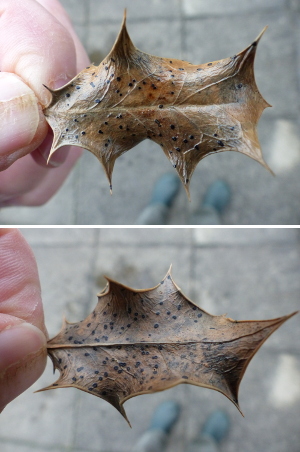 Upper (top) and lower (bottom) leaf surfaces.
Upper (top) and lower (bottom) leaf surfaces.
Richard Shillaker, 1 January 2021
Wawne - top 20 garden birds 2020
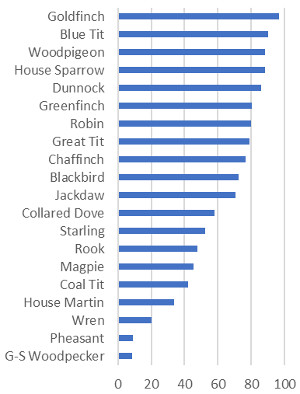 Over 2020 I kept a daily record of all (identifiable) birds seen or heard from our Wawne garden. Travel restrictions and cancelled holidays resulted in an unbroken sequence of 366 lists with 47 observed species. The above chart shows the frequency of occurrence (as a % of days listed) of the twenty most frequent species.
Over 2020 I kept a daily record of all (identifiable) birds seen or heard from our Wawne garden. Travel restrictions and cancelled holidays resulted in an unbroken sequence of 366 lists with 47 observed species. The above chart shows the frequency of occurrence (as a % of days listed) of the twenty most frequent species.
Goldfinch has been the clear winner, with small "charms" being lured by sunflower hearts several times during most days.
The quietness of the lockdown gave 28 days of Skylark song and even the Cuckoo managed to make it onto two lists.
The discipline of keeping a constant look-out for something new has been quite rewarding, resulting in both Yellow and Grey Wagtails, Curlew, Blackcap and Chiffchaff. Although it was a very simple exercise it has yielded quite an interesting base-line data set which is going to take some time to analyse.
Richard Middleton, 3 January 2020
 Witches' Brooms, galls comprising a cluster of twigs, caused the ascomycete fungus Taphrina betulina, are well known on Birch trees. Another type of Witches' Broom can be found on Willows and Sallows. Several were seen on Willows on the edge of Hornsea Mere during the Hull Nats trip on 6th November. This gall is formed from a catkin and can vary in appearance. The ones I saw seemed to be a mass of small dull greyish brown leaf-like structures. The identity of the gall causer is uncertain. These galls often contain eriophyoid mites (Stenacis triradiatus), which even as adults look a bit like tiny maggots with two pairs of anterior legs. However it is thought that the mites could be a vector for a virus which causes the gall. It is also possible that the galls might be caused by a phytoplasma. Phytoplasmas are specialised bacteria lacking a cell wall that live in the phloem of plants and are transmitted by sap-sucking insects. Disruption of the phloem transport of sugars and other products might lead to the development of distorted catkins.
Witches' Brooms, galls comprising a cluster of twigs, caused the ascomycete fungus Taphrina betulina, are well known on Birch trees. Another type of Witches' Broom can be found on Willows and Sallows. Several were seen on Willows on the edge of Hornsea Mere during the Hull Nats trip on 6th November. This gall is formed from a catkin and can vary in appearance. The ones I saw seemed to be a mass of small dull greyish brown leaf-like structures. The identity of the gall causer is uncertain. These galls often contain eriophyoid mites (Stenacis triradiatus), which even as adults look a bit like tiny maggots with two pairs of anterior legs. However it is thought that the mites could be a vector for a virus which causes the gall. It is also possible that the galls might be caused by a phytoplasma. Phytoplasmas are specialised bacteria lacking a cell wall that live in the phloem of plants and are transmitted by sap-sucking insects. Disruption of the phloem transport of sugars and other products might lead to the development of distorted catkins.


 This fungus Xylaria polymorpha, commonly called Dead Man’s Fingers, was found at the base of a stump of a cut down tree in Brantingham on 4th November. The white powder on the tips of the fingers consists of the asexually produced conidiospores. The fungus also reproduces sexually via dark brown ascospores.
This fungus Xylaria polymorpha, commonly called Dead Man’s Fingers, was found at the base of a stump of a cut down tree in Brantingham on 4th November. The white powder on the tips of the fingers consists of the asexually produced conidiospores. The fungus also reproduces sexually via dark brown ascospores.
 I spotted a small green/yellow patch (green island) in an otherwise brown leaf on a Beech tree in Welton Dale. The green/yellow area contained the twisting mine of the larva of a micromoth, the Small Beech Pigmy Stigmella tityrella (mine characterised by starting in angle of a vein close to the midrib). The larva of this moth is thought to have a symbiotic bacterium which is responsible for causing the release of cytokinins which delay leaf senescence (keeping the leaf green and containing nutrients), thus maintaining a food source for the larva. The green island in this leaf is turning yellow, probably because the larva is no longer present.
I spotted a small green/yellow patch (green island) in an otherwise brown leaf on a Beech tree in Welton Dale. The green/yellow area contained the twisting mine of the larva of a micromoth, the Small Beech Pigmy Stigmella tityrella (mine characterised by starting in angle of a vein close to the midrib). The larva of this moth is thought to have a symbiotic bacterium which is responsible for causing the release of cytokinins which delay leaf senescence (keeping the leaf green and containing nutrients), thus maintaining a food source for the larva. The green island in this leaf is turning yellow, probably because the larva is no longer present.
 While searching through the Mappleton parish registers for a family baptism I came across the following unusual entry for 1687 -
While searching through the Mappleton parish registers for a family baptism I came across the following unusual entry for 1687 -  We found these rare solitary bees foraging for pollen and nectar on the abundant Sea Aster (Aster tripolium) at Skeffling [top]. Africa then led us to where there are known nesting aggregations in sand pits at Welwick Saltmarsh [middle], where there is also abundant Sea Aster, here protected by fencing from grazing sheep. The Sea Aster is their key food plant for pollen, though they will nectar from other plants. The global population is all on southern North Sea coasts up to the Humber, in such saltmarsh habitats.
We found these rare solitary bees foraging for pollen and nectar on the abundant Sea Aster (Aster tripolium) at Skeffling [top]. Africa then led us to where there are known nesting aggregations in sand pits at Welwick Saltmarsh [middle], where there is also abundant Sea Aster, here protected by fencing from grazing sheep. The Sea Aster is their key food plant for pollen, though they will nectar from other plants. The global population is all on southern North Sea coasts up to the Humber, in such saltmarsh habitats. I have been trying to record plants at the Sculcoates patch, aided by the distribution in the Hull plant project maps. I noticed Traveller's-joy is not that common in Hull, but today I found a large plant flowering by the railway line just outside the km square at TA09173100. It is very obvious now that it is flowering. I took a record shot and when I checked it at home I realised that there is a Volucella zonaria in it. Not a common hoverfly by any means!
I have been trying to record plants at the Sculcoates patch, aided by the distribution in the Hull plant project maps. I noticed Traveller's-joy is not that common in Hull, but today I found a large plant flowering by the railway line just outside the km square at TA09173100. It is very obvious now that it is flowering. I took a record shot and when I checked it at home I realised that there is a Volucella zonaria in it. Not a common hoverfly by any means!
 A freshly-dead Common Toad found beside the path at Aldbrough. The animal had an infection of a fly, Lucilia bufonivora, the larvae of which feed on the tissues around the nostrils.
A freshly-dead Common Toad found beside the path at Aldbrough. The animal had an infection of a fly, Lucilia bufonivora, the larvae of which feed on the tissues around the nostrils.
 Among the many delights awaiting in my moth trap yesterday morning was this huge female Oak Eggar, pictured above on the side of an egg-box. This moth is usually more likely to be encountered on the North Yorkshire Moors than Holderness.
Among the many delights awaiting in my moth trap yesterday morning was this huge female Oak Eggar, pictured above on the side of an egg-box. This moth is usually more likely to be encountered on the North Yorkshire Moors than Holderness.
 Whitcliffe Common
Whitcliffe Common
 Cramer Gutter SSSI
Cramer Gutter SSSI

 As I walked by the Oak Road playing fields yesterday I noticed an odd bird feeding on the grass. I couldn't believe my eyes: it is a silvery crow! I remembered that Andy Gibson messaged me about such a bird on New Years Day. I went to find it the following day and I have been visiting the area regularly, so it has taken me over 4 months to find it. It is likely to be a genetic variant of the usual colour plumage, instead of it being due to poor nutrition (as exemplified by this very tame young bird at West Park). Carrion Crow young being fed on bread appear to suffer from discolouration of their primaries, and are more frequent around public parks. They might grow black feathers in their next moult, but in the meantime, the white feathers fray more easily and sometimes these crows look like they have to make more effort to fly.
As I walked by the Oak Road playing fields yesterday I noticed an odd bird feeding on the grass. I couldn't believe my eyes: it is a silvery crow! I remembered that Andy Gibson messaged me about such a bird on New Years Day. I went to find it the following day and I have been visiting the area regularly, so it has taken me over 4 months to find it. It is likely to be a genetic variant of the usual colour plumage, instead of it being due to poor nutrition (as exemplified by this very tame young bird at West Park). Carrion Crow young being fed on bread appear to suffer from discolouration of their primaries, and are more frequent around public parks. They might grow black feathers in their next moult, but in the meantime, the white feathers fray more easily and sometimes these crows look like they have to make more effort to fly.

 I've been for a long walk to the north limits of the city following the Beverley and Barmston drain. Had a close look at the Mistletoe, and nearby was a little flock of Siskin coming down to drink on a puddle after feeding on the Alders. Also had my first Colt's-foot by Oak Road Lake, and my 2nd picnic of the year!
I've been for a long walk to the north limits of the city following the Beverley and Barmston drain. Had a close look at the Mistletoe, and nearby was a little flock of Siskin coming down to drink on a puddle after feeding on the Alders. Also had my first Colt's-foot by Oak Road Lake, and my 2nd picnic of the year!
 As the lockdown was announced, a strong sense of déjà vu, what to do? how to fill the quota of wildlife I need to stay afloat from the madness of this world. I need a local patch, within walking distance, and diverse enough in habitats that it will keep me busy recording in it. So I decided onto Sculcoates square (TA0930), with a river, a drain, lots of scrubby, brownfield places and three cemeteries. I have planned to visit at least weekly year round and if you want to follow my patch adventures, check my
As the lockdown was announced, a strong sense of déjà vu, what to do? how to fill the quota of wildlife I need to stay afloat from the madness of this world. I need a local patch, within walking distance, and diverse enough in habitats that it will keep me busy recording in it. So I decided onto Sculcoates square (TA0930), with a river, a drain, lots of scrubby, brownfield places and three cemeteries. I have planned to visit at least weekly year round and if you want to follow my patch adventures, check my  Chris Sulston spotted this female Red-crested Pochard on East Park lake at the end of last year. They occur commonly in Europe, but are fairly rare visitors or escapees in the UK. East Park has a good selection of waterfowl and is well worth a visit.[AC]
Chris Sulston spotted this female Red-crested Pochard on East Park lake at the end of last year. They occur commonly in Europe, but are fairly rare visitors or escapees in the UK. East Park has a good selection of waterfowl and is well worth a visit.[AC]
 We were grateful when the lashing rain stopped just as we arrived at King Rudding Lane. We found over 40 species of fungi, and other highlights included three Black Darter dragonflies, two Leopard Slugs, one with eggs, and a nest of baby newts, all found by Africa.
We were grateful when the lashing rain stopped just as we arrived at King Rudding Lane. We found over 40 species of fungi, and other highlights included three Black Darter dragonflies, two Leopard Slugs, one with eggs, and a nest of baby newts, all found by Africa.
 I went to Victoria Dock area on Tuesday. At the end of Corinthian Way, there is a little bit of a beach (the only beach in Hull!) The beach is shingle, although, this having been a shipyard a few decades ago, there is also plenty of rubble and even some rocky patches, possibly made out of slag. Some salt marsh plants have established, including Sea Aster and Marram Grass. I noticed the tide line of wrack and had a poke to check what was under it. There were many sandhoppers, far too quick for photos, but I managed to get a few photos of some sea slaters, Ligia oceanica, the largest I've seen, about 3 cm long. These are relatives of woodlice and usually live in rocky shores.
I went to Victoria Dock area on Tuesday. At the end of Corinthian Way, there is a little bit of a beach (the only beach in Hull!) The beach is shingle, although, this having been a shipyard a few decades ago, there is also plenty of rubble and even some rocky patches, possibly made out of slag. Some salt marsh plants have established, including Sea Aster and Marram Grass. I noticed the tide line of wrack and had a poke to check what was under it. There were many sandhoppers, far too quick for photos, but I managed to get a few photos of some sea slaters, Ligia oceanica, the largest I've seen, about 3 cm long. These are relatives of woodlice and usually live in rocky shores.
 At the last minute, I decided to take my camera on Daisy’s walk over Beverley Westwood. While walking along the western boundary and looking at a couple of dragonflies, out of the corner of my eyes, I saw something land on a thistle head. I was too far away to see what it was so I took a photo (600mm equivalent lens). When I zoomed in to see what it was I realised it was a White-letter Hairstreak so took a few more. As it seemed settled, I changed position, knelt down so I only had grass in the background and took the above shot. I believe they have been seen in Thwaite Gardens but, otherwise, are not known from this area.
At the last minute, I decided to take my camera on Daisy’s walk over Beverley Westwood. While walking along the western boundary and looking at a couple of dragonflies, out of the corner of my eyes, I saw something land on a thistle head. I was too far away to see what it was so I took a photo (600mm equivalent lens). When I zoomed in to see what it was I realised it was a White-letter Hairstreak so took a few more. As it seemed settled, I changed position, knelt down so I only had grass in the background and took the above shot. I believe they have been seen in Thwaite Gardens but, otherwise, are not known from this area.
 On our Tuesday evening visit to Keyingham Gravel Pit I was able to collect several shells of the small fresh-water bivalve Corbicula fluminalis. Although mixed in with a range of marine molluscs, such as Cockle, still commonly found around our coast, these are now only encountered in fresh, warm water and are long extinct in Britain. It is believed that they represent animals once living in the streams which re-shaped the local landscape as the ice of the last glacial period melted. The marine shells, which are often broken, were derived from sediment incorporated into the glaciers as they moved over the sea floor.
On our Tuesday evening visit to Keyingham Gravel Pit I was able to collect several shells of the small fresh-water bivalve Corbicula fluminalis. Although mixed in with a range of marine molluscs, such as Cockle, still commonly found around our coast, these are now only encountered in fresh, warm water and are long extinct in Britain. It is believed that they represent animals once living in the streams which re-shaped the local landscape as the ice of the last glacial period melted. The marine shells, which are often broken, were derived from sediment incorporated into the glaciers as they moved over the sea floor.
 We discovered galls among a patch of grasses including Agrostis stolonifera in an unmown area of the Barbara Robson Aquagreen. Andrew discovered they had killed off the flowering shoots and quickly consulted his phone to discover it was Epichloe baconii, a 'choke grass' fungus. It only becomes visible when it’s ready to shed its spores in its sexual reproductive stage. This begins as a white collar around the immature flowerheads of mainly Agrostis species, inhibiting their growth. It then turns yellow/orange as spore-bearing asci (sacs) become visible (as in the picture). It seems that the fungus attracts flies from the genus Botanophila, which feed on the fungal material before laying their eggs on another grass of the species which is also infected. The fungus will then reproduce, and the fly larvae in turn will benefit from the food source of the fungi.
We discovered galls among a patch of grasses including Agrostis stolonifera in an unmown area of the Barbara Robson Aquagreen. Andrew discovered they had killed off the flowering shoots and quickly consulted his phone to discover it was Epichloe baconii, a 'choke grass' fungus. It only becomes visible when it’s ready to shed its spores in its sexual reproductive stage. This begins as a white collar around the immature flowerheads of mainly Agrostis species, inhibiting their growth. It then turns yellow/orange as spore-bearing asci (sacs) become visible (as in the picture). It seems that the fungus attracts flies from the genus Botanophila, which feed on the fungal material before laying their eggs on another grass of the species which is also infected. The fungus will then reproduce, and the fly larvae in turn will benefit from the food source of the fungi.  I walked north from Raich Carter Way on the river bank this morning and saw a Peregrine landing on one of the pylons
- wrong light, too windy and the Peregrine was intent on preening the back of its tail so I only got poor photos.
I walked north from Raich Carter Way on the river bank this morning and saw a Peregrine landing on one of the pylons
- wrong light, too windy and the Peregrine was intent on preening the back of its tail so I only got poor photos.

 In the interesting visit to Welton Top on Tuesday I found this little door snail on a tree trunk. It is a Toothed Door Snail, Clausilia bidentata. Although a common species in the UK, records appear to be concentrated in the Wolds in East Yorkshire. It lives in woods and hedges and is active at night and in damp weather, when it climbs onto trees or rocks to feed on lichens.
In the interesting visit to Welton Top on Tuesday I found this little door snail on a tree trunk. It is a Toothed Door Snail, Clausilia bidentata. Although a common species in the UK, records appear to be concentrated in the Wolds in East Yorkshire. It lives in woods and hedges and is active at night and in damp weather, when it climbs onto trees or rocks to feed on lichens.

 Four members attended our first field trip after the latest lockdown. There was a good range of birds, both on the water and in the woodland with the star record being a Great White Egret. Although early for many flowers, we found a patch of Rue-leaved Saxifrage (Saxifraga tridactylites)- top - not far from the car park. In the floodplain meadow were Cuckooflower (Cardamine pratensis) and Marsh-marigold (Caltha palustris) amongst what promises to be a good display of Great Burnet (Sanguisorba officinalis). We were interested to find most of the patches of Broad-leaved Dock crawling with iridescent green beetles which were busy mating and laying eggs - middle. These were identified as Green Dock Beetles (Gastrophysa viridula)! Other finds included the fungus Blushing Bracket (Daedaleopsis confragosa) and a slime mould, the False Puffball (Enteridium lycoperdon) - bottom - about to crack and release its spores.
Four members attended our first field trip after the latest lockdown. There was a good range of birds, both on the water and in the woodland with the star record being a Great White Egret. Although early for many flowers, we found a patch of Rue-leaved Saxifrage (Saxifraga tridactylites)- top - not far from the car park. In the floodplain meadow were Cuckooflower (Cardamine pratensis) and Marsh-marigold (Caltha palustris) amongst what promises to be a good display of Great Burnet (Sanguisorba officinalis). We were interested to find most of the patches of Broad-leaved Dock crawling with iridescent green beetles which were busy mating and laying eggs - middle. These were identified as Green Dock Beetles (Gastrophysa viridula)! Other finds included the fungus Blushing Bracket (Daedaleopsis confragosa) and a slime mould, the False Puffball (Enteridium lycoperdon) - bottom - about to crack and release its spores.
 On the 30th of December I headed to Withernsea to see the stranded Sperm Whales. I've never seen a stranded whale before and I was saddened by their misfortune, but incredibly curious to see these animals up close. Five whales were stranded and a team was carrying out the necropsies. The individual closest to Withernsea is pictured in the photo.
On the 30th of December I headed to Withernsea to see the stranded Sperm Whales. I've never seen a stranded whale before and I was saddened by their misfortune, but incredibly curious to see these animals up close. Five whales were stranded and a team was carrying out the necropsies. The individual closest to Withernsea is pictured in the photo.


 These small, dark green overwintering buds (turions) on Frogbit, from my garden pond, were photographed on 29th September. They look quite different to the turions of Whorled Water-milfoil featured in the news item below by Gabrielle Jarvis. An informative series of photographs showing the annual life cycle of Frogbit, including development of the turion in spring, can be found on the
These small, dark green overwintering buds (turions) on Frogbit, from my garden pond, were photographed on 29th September. They look quite different to the turions of Whorled Water-milfoil featured in the news item below by Gabrielle Jarvis. An informative series of photographs showing the annual life cycle of Frogbit, including development of the turion in spring, can be found on the  Retrieved by Bill Dolling rom the Barmston Drain on Swinemoor: bright green turion growing on Whorled Water-milfoil. A turion is a wintering bud formed from a modified shoot apex, produced in autumn. It will detach itself and sink to the bottom where the mud will be warm enough to preserve it, rising in spring.
Retrieved by Bill Dolling rom the Barmston Drain on Swinemoor: bright green turion growing on Whorled Water-milfoil. A turion is a wintering bud formed from a modified shoot apex, produced in autumn. It will detach itself and sink to the bottom where the mud will be warm enough to preserve it, rising in spring.
 A group of Buff-tip caterpillars
found by Bill Dolling demolishing English Elm leaves at Welwick. The adult moth is perfectly camoflaged as a piece of dead twig but is sometimes caught in moth traps (below RM Wawne).
A group of Buff-tip caterpillars
found by Bill Dolling demolishing English Elm leaves at Welwick. The adult moth is perfectly camoflaged as a piece of dead twig but is sometimes caught in moth traps (below RM Wawne).
 The above plant appeared in our greenhouse a few weeks ago and was allowed to grow until an identification was possible. The characteristic fruits show it to be Datura ferox - Longspine Thorn-apple.
The above plant appeared in our greenhouse a few weeks ago and was allowed to grow until an identification was possible. The characteristic fruits show it to be Datura ferox - Longspine Thorn-apple.  Four-spotted Orb Weaver Spiders (Araneus quadratus)are the heaviest spiders in the UK, the females (pictured) becoming swollen with eggs in late summer. They spin their webs close to the ground and prefer grasshoppers, but this one was packaging up a squirming fly until it spotted me looming with my mobile. It froze and then raced to the Timothy grass where it was expertly camouflaged. The females adjust their colouring over several days to match their homes.
Four-spotted Orb Weaver Spiders (Araneus quadratus)are the heaviest spiders in the UK, the females (pictured) becoming swollen with eggs in late summer. They spin their webs close to the ground and prefer grasshoppers, but this one was packaging up a squirming fly until it spotted me looming with my mobile. It froze and then raced to the Timothy grass where it was expertly camouflaged. The females adjust their colouring over several days to match their homes.  Found near Rudston in a field corner inaccessible to the crop sprayer, this tiny plant was once a common arable weed. Venus's-looking-glass is so-called because the seeds look like miniature hand mirrors.
Found near Rudston in a field corner inaccessible to the crop sprayer, this tiny plant was once a common arable weed. Venus's-looking-glass is so-called because the seeds look like miniature hand mirrors.

 I walked by the marina yesterday between showers and remembered the Sea Spleenworts. Last summer they were looking quite dry and dishevelled, but they are back in good form, benefiting from the rains and unaffected by the recent flood defence works.
I walked by the marina yesterday between showers and remembered the Sea Spleenworts. Last summer they were looking quite dry and dishevelled, but they are back in good form, benefiting from the rains and unaffected by the recent flood defence works.
 A pleasant surprise in my moth trap on Monday - a fine specimen of the relatively diminutive Small Elephant Hawkmoth. Normal service was resumed this morning with two examples of its much larger cousin the Elephant Hawkmoth, as pictured in last year's "News" of exactly the same date.
A pleasant surprise in my moth trap on Monday - a fine specimen of the relatively diminutive Small Elephant Hawkmoth. Normal service was resumed this morning with two examples of its much larger cousin the Elephant Hawkmoth, as pictured in last year's "News" of exactly the same date.
 I went to Alkborough Flats today, I hadn't been since our Hull Nats visit the 20th October 2020. As I went by the path I remembered that botanists noted the dry flower stems of Flowering Rush and I looked for it. I found a single plant, and a single flower was open, what a beautiful marginal plant! I shall remember it.
I went to Alkborough Flats today, I hadn't been since our Hull Nats visit the 20th October 2020. As I went by the path I remembered that botanists noted the dry flower stems of Flowering Rush and I looked for it. I found a single plant, and a single flower was open, what a beautiful marginal plant! I shall remember it. The Friends of the General Cemetery in Hull fitted a number of nest boxes in the cemetery last autumn, including two Tawny Owl boxes. You would think that with so many mature trees there wouldn't be a need. However, Tawny Owls rapidly occupied one of the nests. I was alerted to the presence of owlets at the nest entrance a couple of days ago by a friend. I visited them on May 6th and 7th, when I took photos. A wonderful experience! Despite having a nest in use in front of my house for years I had never seen the owlets. On the 7th one of the owlets had 'branched', where they leave the nest, even if they can't fly. I haven't seen them in the last few days so I presume they are now well camouflaged in nearby trees being fed by their parents.
The Friends of the General Cemetery in Hull fitted a number of nest boxes in the cemetery last autumn, including two Tawny Owl boxes. You would think that with so many mature trees there wouldn't be a need. However, Tawny Owls rapidly occupied one of the nests. I was alerted to the presence of owlets at the nest entrance a couple of days ago by a friend. I visited them on May 6th and 7th, when I took photos. A wonderful experience! Despite having a nest in use in front of my house for years I had never seen the owlets. On the 7th one of the owlets had 'branched', where they leave the nest, even if they can't fly. I haven't seen them in the last few days so I presume they are now well camouflaged in nearby trees being fed by their parents.
 I've spent a couple of hours dissecting the three fresh pellets I collected from under the Pine tree nest box on our trip to Allerthorpe common on the 25th April. They contained a large number of shrews, with other prey being just 2 Field Voles and a couple of bird wing bones
I've spent a couple of hours dissecting the three fresh pellets I collected from under the Pine tree nest box on our trip to Allerthorpe common on the 25th April. They contained a large number of shrews, with other prey being just 2 Field Voles and a couple of bird wing bones When visiting Easington at the end of last year I was struck by a broad band of brown, dirty-looking, sand at the top of the beach. I collected a sample of this material which proved to be half as heavy again as normal beach sand.
When visiting Easington at the end of last year I was struck by a broad band of brown, dirty-looking, sand at the top of the beach. I collected a sample of this material which proved to be half as heavy again as normal beach sand. Upper (top) and lower (bottom) leaf surfaces.
Upper (top) and lower (bottom) leaf surfaces.
 Over 2020 I kept a daily record of all (identifiable) birds seen or heard from our Wawne garden. Travel restrictions and cancelled holidays resulted in an unbroken sequence of 366 lists with 47 observed species. The above chart shows the frequency of occurrence (as a % of days listed) of the twenty most frequent species.
Over 2020 I kept a daily record of all (identifiable) birds seen or heard from our Wawne garden. Travel restrictions and cancelled holidays resulted in an unbroken sequence of 366 lists with 47 observed species. The above chart shows the frequency of occurrence (as a % of days listed) of the twenty most frequent species.